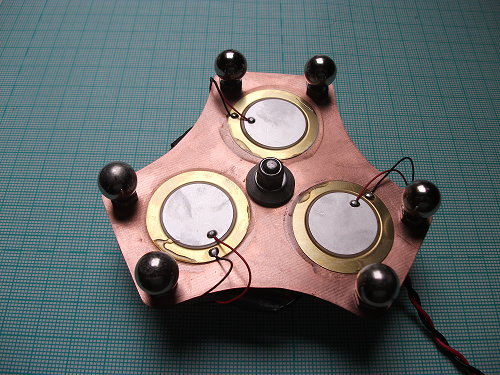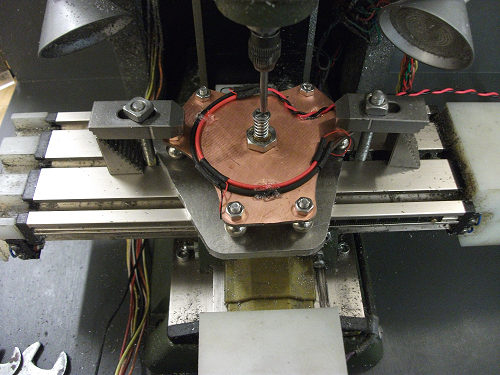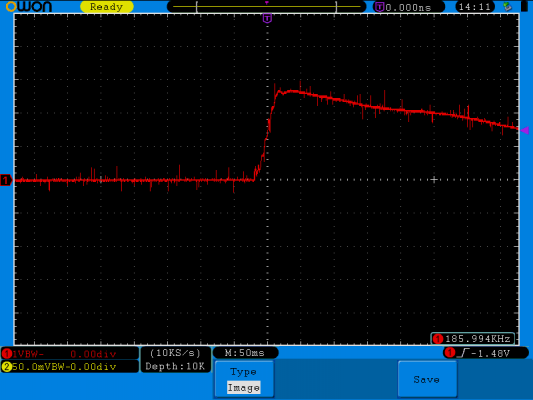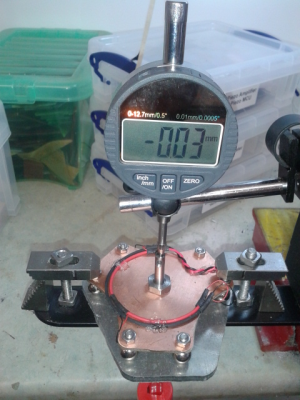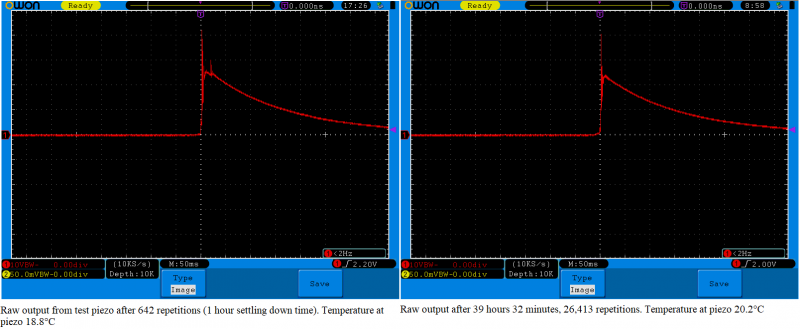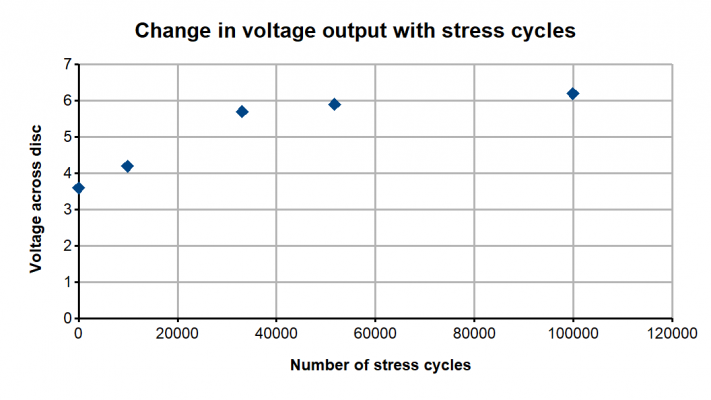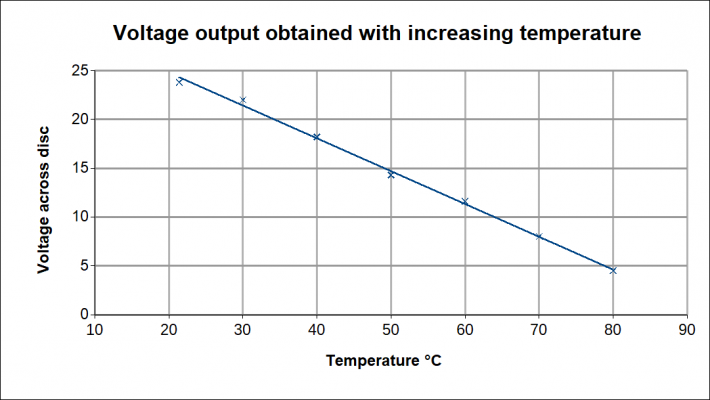Piezoelectric disks for Z contact detect and bed levelling
Posted by leadinglights
|
Re: Piezoelectric disks for Z contact detect and bed levelling August 07, 2017 02:33AM |
Registered: 8 years ago Posts: 3,525 |
Yes that's no problem.
I have had quite long piezo leads on some setups without issue, depends on whether they are near other cables that can generate interference.
Simon Khoury
Co-founder of [www.precisionpiezo.co.uk] Accurate, repeatable, versatile Z-Probes
Published:Inventions
I have had quite long piezo leads on some setups without issue, depends on whether they are near other cables that can generate interference.
Simon Khoury
Co-founder of [www.precisionpiezo.co.uk] Accurate, repeatable, versatile Z-Probes
Published:Inventions
|
Re: Piezoelectric disks for Z contact detect and bed levelling August 07, 2017 02:35AM |
Registered: 8 years ago Posts: 3,525 |
Yes that's fine.
Simon Khoury
Co-founder of [www.precisionpiezo.co.uk] Accurate, repeatable, versatile Z-Probes
Published:Inventions
Simon Khoury
Co-founder of [www.precisionpiezo.co.uk] Accurate, repeatable, versatile Z-Probes
Published:Inventions
|
Re: Piezoelectric disks for Z contact detect and bed levelling August 07, 2017 04:33PM |
Registered: 10 years ago Posts: 293 |
|
Re: Piezoelectric disks for Z contact detect and bed levelling August 07, 2017 04:40PM |
Registered: 8 years ago Posts: 3,525 |
No worries. Post it there if you like, or post a pic of your solution when its up and running.
Simon Khoury
Co-founder of [www.precisionpiezo.co.uk] Accurate, repeatable, versatile Z-Probes
Published:Inventions
Simon Khoury
Co-founder of [www.precisionpiezo.co.uk] Accurate, repeatable, versatile Z-Probes
Published:Inventions
|
Re: Piezoelectric disks for Z contact detect and bed levelling August 07, 2017 09:36PM |
Registered: 10 years ago Posts: 293 |
My short term idea is to relocate the board with an adapter I have yet to lay out. The longer term solution would be to make a version of your parts that would mount directly on the three posts. I think someone may have used the 27mm disc and made an adapter for the 713Maker effector already. I may need to order another set to try that. ;-)
|
Re: Piezoelectric disks for Z contact detect and bed levelling August 08, 2017 01:51AM |
Registered: 8 years ago Posts: 3,525 |
Have a look on duet forum I think Kraegar there made something that works with a 713 maker setup.
Simon Khoury
Co-founder of [www.precisionpiezo.co.uk] Accurate, repeatable, versatile Z-Probes
Published:Inventions
Simon Khoury
Co-founder of [www.precisionpiezo.co.uk] Accurate, repeatable, versatile Z-Probes
Published:Inventions
|
Re: Piezoelectric disks for Z contact detect and bed levelling August 08, 2017 09:34PM |
Registered: 10 years ago Posts: 293 |
Yes, I found his on thingiverse and ordered a 27mm kit to try that setup. I'll use the preassembled 20mn setup I bought previously on my Tevo Little Monster. Right now I'm trying to finish up the parts for a 3DPrintLab Qtrainer. Since I only have one working printer at the moment no messing with it until I get the plane parts finished. ;-)
Oh and I print those parts for the Rostock since that's a project for the weekend also.
Edited 1 time(s). Last edit at 08/08/2017 09:35PM by WZ9V.
Oh and I print those parts for the Rostock since that's a project for the weekend also.
Edited 1 time(s). Last edit at 08/08/2017 09:35PM by WZ9V.
|
Re: Piezoelectric disks for Z contact detect and bed levelling August 09, 2017 01:56PM |
Registered: 9 years ago Posts: 752 |
@Leadinglights: Thanks! I've tested cutting with the spindle and working out some problems today.
Here are some videos of the process:
First cut:
[youtu.be]
Interference with the VFD on the z axis stepper motor:
[youtu.be]
Timelapse building the mechanical kit:
[youtu.be]
3D printers aren't very good for isolation routing, at least not using the prusa i3 design because of the gravity assisted x axis, you can't plunge into a material with it very well. And the nema 17 stepper motors aren't very powerful, especially at 16x microstepping. Hopefully I'll get the warp feature (similar to auto bed leveling) working at some point, that should help with isolation milling. I probably need a different controller board.
--
Kind regards
Imqqmi
NFAN CoreXY printer:
[reprap.org]
Here are some videos of the process:
First cut:
[youtu.be]
Interference with the VFD on the z axis stepper motor:
[youtu.be]
Timelapse building the mechanical kit:
[youtu.be]
3D printers aren't very good for isolation routing, at least not using the prusa i3 design because of the gravity assisted x axis, you can't plunge into a material with it very well. And the nema 17 stepper motors aren't very powerful, especially at 16x microstepping. Hopefully I'll get the warp feature (similar to auto bed leveling) working at some point, that should help with isolation milling. I probably need a different controller board.
--
Kind regards
Imqqmi
NFAN CoreXY printer:
[reprap.org]
|
Re: Piezoelectric disks for Z contact detect and bed levelling August 12, 2017 12:38PM |
Registered: 12 years ago Posts: 1,450 |
Just a quick mention that the XY noise cancelling piezo head (Earlier post [forums.reprap.org] ) while very pretty is a bit over the top. The reduction in X and Y sensitivity was a bit better than 50% in trials that I have done with weights to simulate typical hot ends so not worth the complexity.
The simple use of a delay before probing means that I have not seen a single false trigger on my Cartesian printer since setting up the delay. Calculating the contact pressure from the spring rate and a scope trace from the micros it triggers cleanly at 16 grams of pressure. Even the most rattling from the printer the trigger is about 60% to 70% above the mechanical noise. I am very happy with 16 grams and will not pursue mechanical cancellation. Meanwhile, the digital processing with a very small micro-controller is looking very promising: The most interesting bit is that I can sample, smooth and validate a trigger at 16,000 samples per second and it may be possible to use the samples to diagnose/tune the Z probe, and display them on a graphic display - somewhat like having a built in oscilloscope.
Mike
The simple use of a delay before probing means that I have not seen a single false trigger on my Cartesian printer since setting up the delay. Calculating the contact pressure from the spring rate and a scope trace from the micros it triggers cleanly at 16 grams of pressure. Even the most rattling from the printer the trigger is about 60% to 70% above the mechanical noise. I am very happy with 16 grams and will not pursue mechanical cancellation. Meanwhile, the digital processing with a very small micro-controller is looking very promising: The most interesting bit is that I can sample, smooth and validate a trigger at 16,000 samples per second and it may be possible to use the samples to diagnose/tune the Z probe, and display them on a graphic display - somewhat like having a built in oscilloscope.
Mike
|
Re: Piezoelectric disks for Z contact detect and bed levelling August 17, 2017 06:00PM |
Registered: 9 years ago Posts: 752 |
Thanks for testing that option Leadinglights.
I agree, the microcontroller version opens up a lot of possibilities. The more it's integrated into the control system the better. What about a continuous drag probe for probing the bed by measuring the changes of pressure by rapidly moving the probe up and down the bed? I'm not sure if it's possible to accurately relate the voltage level to the depth of the bed.
--
Kind regards
Imqqmi
NFAN CoreXY printer:
[reprap.org]
I agree, the microcontroller version opens up a lot of possibilities. The more it's integrated into the control system the better. What about a continuous drag probe for probing the bed by measuring the changes of pressure by rapidly moving the probe up and down the bed? I'm not sure if it's possible to accurately relate the voltage level to the depth of the bed.
--
Kind regards
Imqqmi
NFAN CoreXY printer:
[reprap.org]
|
Re: Piezoelectric disks for Z contact detect and bed levelling August 24, 2017 12:46PM |
Registered: 12 years ago Posts: 1,450 |
I was just looking through the Delta section of the forum when I came across a posting by Minatavrus who is showing off the new Smart PCB Effector he got from DC42 [forums.reprap.org]
A close look at the photos reveals that this is not just a strikingly good looking design it is also a really good bit of engineering. The foil strain gauges are etched into the PCB surfaces and are in the form of a half bridge with the three "petals" on each side being in series - this is both simpler and would work better than most other arrangements on a three legged structure such as a Delta printer. The choice of an ATTiny is also inspired as it is easily capable of doing quite sophisticated data processing -- and lots of other things besides the pretty face.
Is this competition for the Piezo sensors? Hell yeah! Does it kill the Piezo sensors? I don't think so: Etching lines as fine as those needed for the strain elements is not trivial and cheaper PCB fabs will give a variable quality so I don't think that strain gauge methods will be as cheap as piezo disk based ones. Sensitivity, accuracy and repeatibility are likely to be in the same ball park - but in both far more than is needed. One clear win with the strain gauge based Z probes that they should work easily up to 85C to 100C.
Mike
A close look at the photos reveals that this is not just a strikingly good looking design it is also a really good bit of engineering. The foil strain gauges are etched into the PCB surfaces and are in the form of a half bridge with the three "petals" on each side being in series - this is both simpler and would work better than most other arrangements on a three legged structure such as a Delta printer. The choice of an ATTiny is also inspired as it is easily capable of doing quite sophisticated data processing -- and lots of other things besides the pretty face.
Is this competition for the Piezo sensors? Hell yeah! Does it kill the Piezo sensors? I don't think so: Etching lines as fine as those needed for the strain elements is not trivial and cheaper PCB fabs will give a variable quality so I don't think that strain gauge methods will be as cheap as piezo disk based ones. Sensitivity, accuracy and repeatibility are likely to be in the same ball park - but in both far more than is needed. One clear win with the strain gauge based Z probes that they should work easily up to 85C to 100C.
Mike
|
Re: Piezoelectric disks for Z contact detect and bed levelling August 24, 2017 12:51PM |
Registered: 8 years ago Posts: 3,525 |
Well I did wonder if it would make a difference to my Piezo20 modules sales but I've had quite a few enquiries and a few orders we have pcbs in stock now.
I've got a pcb effector and it does work well about the same accuracy and repeatability as piezo but it's a trick unit and very fairly priced. So respect to dc and T3P3.
The piezo system though can be adapted to practically any printer not just deltas with magnetic arms.
There is a good bit of discussion going on over at the duet forum there's a dedicated smart effector section. You do have to keep powerful fans away from the strain gauge or it starts triggering but I remixed an e3d fan shroud to have a bit more lateral extension.
Edited 1 time(s). Last edit at 08/24/2017 12:57PM by DjDemonD.
Simon Khoury
Co-founder of [www.precisionpiezo.co.uk] Accurate, repeatable, versatile Z-Probes
Published:Inventions
I've got a pcb effector and it does work well about the same accuracy and repeatability as piezo but it's a trick unit and very fairly priced. So respect to dc and T3P3.
The piezo system though can be adapted to practically any printer not just deltas with magnetic arms.
There is a good bit of discussion going on over at the duet forum there's a dedicated smart effector section. You do have to keep powerful fans away from the strain gauge or it starts triggering but I remixed an e3d fan shroud to have a bit more lateral extension.
Edited 1 time(s). Last edit at 08/24/2017 12:57PM by DjDemonD.
Simon Khoury
Co-founder of [www.precisionpiezo.co.uk] Accurate, repeatable, versatile Z-Probes
Published:Inventions
|
Re: Piezoelectric disks for Z contact detect and bed levelling September 16, 2017 06:59AM |
Registered: 12 years ago Posts: 1,450 |
Inspired by DC42s PCB effector with built in strain gauge nozzle contact detection I thought that I would try the same idea but using piezo elements instead of the strain gauges. Initial results are very encouraging with the lowest natural compliance that I have seen on anything - about 1 micron per 10 grams of pressure (at least part of which is from the test rig)
I conducted some tests by putting the effector on the bed of a CNC milling machine (Proxxon MF70). The button in the middle is spring loaded to limit the pressure on the effector to 400 grams. The Z feed was set to 1mm per second with pre-travel of 1mm and post travel of 0.5mm so that Z acceleration and decelleration wouldn't influence the results.
The plot below is typical of the output. The display is set to 1V per cm vertically and 50ms per cm horizontally. The peak occurs when the spring comes into action at 400 grams after 40ms. The signal is disappointingly less than I had hoped but still very usable, the noise is also quite large but this is partly because the milling machine really sucks as a low noise environment but also it looks more with the smallish signal.
The last photo shows that this has RepRap-ish credentials as the PCB was routed out on a 3D printer.
I am not sure if I will pursue this line of inquiry as I have a lot on at the moment but if the ideas are of use to anbody my terms are the usual WTFPL [www.wtfpl.net]
Mike
I conducted some tests by putting the effector on the bed of a CNC milling machine (Proxxon MF70). The button in the middle is spring loaded to limit the pressure on the effector to 400 grams. The Z feed was set to 1mm per second with pre-travel of 1mm and post travel of 0.5mm so that Z acceleration and decelleration wouldn't influence the results.
The plot below is typical of the output. The display is set to 1V per cm vertically and 50ms per cm horizontally. The peak occurs when the spring comes into action at 400 grams after 40ms. The signal is disappointingly less than I had hoped but still very usable, the noise is also quite large but this is partly because the milling machine really sucks as a low noise environment but also it looks more with the smallish signal.
The last photo shows that this has RepRap-ish credentials as the PCB was routed out on a 3D printer.
I am not sure if I will pursue this line of inquiry as I have a lot on at the moment but if the ideas are of use to anbody my terms are the usual WTFPL [www.wtfpl.net]
Mike
|
Re: Piezoelectric disks for Z contact detect and bed levelling September 17, 2017 02:21PM |
Registered: 8 years ago Posts: 487 |
Is that standard 1.6mm PCB? I like the idea of an effector milled out of PCB but I always worry that it's going to be too flexible. I suppose though that the important axis, x and y are planar to the PCB and flex in the z axis isn't as important.
Idris
{Precision Piezo} Accurate, repeatable, versatile z-probe plus piezo discs, endstop cables, pt100, 50w heaters.
Idris
{Precision Piezo} Accurate, repeatable, versatile z-probe plus piezo discs, endstop cables, pt100, 50w heaters.
|
Re: Piezoelectric disks for Z contact detect and bed levelling September 17, 2017 03:25PM |
Registered: 12 years ago Posts: 1,450 |
Hi Idris,
Yes it is 1.6mm FR4 with copper on both sides. I would only worry about flexibility if the hotend extends far enough to make for a very long lever. The flexibility at any reasonable hotend nozzle should be somewhere around what I got for contact compliance - say in the ballpark of 1 thousandth of an inch for 1 pound of load.
Mike
Yes it is 1.6mm FR4 with copper on both sides. I would only worry about flexibility if the hotend extends far enough to make for a very long lever. The flexibility at any reasonable hotend nozzle should be somewhere around what I got for contact compliance - say in the ballpark of 1 thousandth of an inch for 1 pound of load.
Mike
|
Re: Piezoelectric disks for Z contact detect and bed levelling September 17, 2017 03:33PM |
Registered: 8 years ago Posts: 3,525 |
It surprised that the PCB effector is stiff enough and that 1.6mm but it calibrates to the same accuracy as the piezo effector I had on there before so it must be stiff enough. The carriages are 2mm, which does seem somewhat stiffer.
Simon Khoury
Co-founder of [www.precisionpiezo.co.uk] Accurate, repeatable, versatile Z-Probes
Published:Inventions
Simon Khoury
Co-founder of [www.precisionpiezo.co.uk] Accurate, repeatable, versatile Z-Probes
Published:Inventions
|
Re: Piezoelectric disks for Z contact detect and bed levelling September 18, 2017 05:06AM |
Registered: 8 years ago Posts: 487 |
I've been using piezos soldered to pcb pucks inserted in to a printed frame but I think I might put together a PCB effector to try out. Aluminium cored PCB is now available at about 2.5x the cost of FR4 though at 1.6mm it might not actually be any stiffer. 2mm FR4 is roughly 2x the price. I wonder whether you could use an aluminium cored PCB as the heatsink for the hotend?
Idris
{Precision Piezo} Accurate, repeatable, versatile z-probe plus piezo discs, endstop cables, pt100, 50w heaters.
Idris
{Precision Piezo} Accurate, repeatable, versatile z-probe plus piezo discs, endstop cables, pt100, 50w heaters.
|
Re: Piezoelectric disks for Z contact detect and bed levelling September 18, 2017 05:25AM |
Registered: 8 years ago Posts: 3,525 |
A bit like a titan aero but for delta's, I like that idea. Should a strain gauge be considered as well?
Simon Khoury
Co-founder of [www.precisionpiezo.co.uk] Accurate, repeatable, versatile Z-Probes
Published:Inventions
Simon Khoury
Co-founder of [www.precisionpiezo.co.uk] Accurate, repeatable, versatile Z-Probes
Published:Inventions
|
Re: Piezoelectric disks for Z contact detect and bed levelling September 18, 2017 05:31AM |
Registered: 8 years ago Posts: 487 |
Possibly, I'm not sure what the advantage of a strain gauge is over a piezo disk except that it can be etched into the pcb. If you were to use the pcb as the heatsink then I think you'd have difficulties as the temp changes, strain gauges are very temperature sensitive.
Idris
{Precision Piezo} Accurate, repeatable, versatile z-probe plus piezo discs, endstop cables, pt100, 50w heaters.
Idris
{Precision Piezo} Accurate, repeatable, versatile z-probe plus piezo discs, endstop cables, pt100, 50w heaters.
|
Re: Piezoelectric disks for Z contact detect and bed levelling September 18, 2017 07:59AM |
Registered: 12 years ago Posts: 1,450 |
I was a little worried that I may have somehow got it wrong and that there was more compliance in the PCB than I read so I did a completely different check. Same effector but I am not checking the piezos, just putting a load on and reading the deflection.
The effector was mounted so that all 6 balls rested on an aluminium plate and clamped down in two places. A pull was applied to a fixing on the center of the PCB by a spring scale (also tried 1kg reel of ABS) and the change of reading between the unloaded and loaded conditions measured with a digital DTI.
The result is that it is better than I expected, just 30 microns deflection with 1kg of load - the rest of the error must be in the beds of my milling machine.
I also checked a sideways pull on the rod 25 mm from the PCB and got 70 microns with 1kg of pull.
Mike
The effector was mounted so that all 6 balls rested on an aluminium plate and clamped down in two places. A pull was applied to a fixing on the center of the PCB by a spring scale (also tried 1kg reel of ABS) and the change of reading between the unloaded and loaded conditions measured with a digital DTI.
The result is that it is better than I expected, just 30 microns deflection with 1kg of load - the rest of the error must be in the beds of my milling machine.
I also checked a sideways pull on the rod 25 mm from the PCB and got 70 microns with 1kg of pull.
Mike
|
Re: Piezoelectric disks for Z contact detect and bed levelling September 18, 2017 08:10AM |
Registered: 12 years ago Posts: 1,450 |
Quote
Moriquendi
Possibly, I'm not sure what the advantage of a strain gauge is over a piezo disk except that it can be etched into the pcb. If you were to use the pcb as the heatsink then I think you'd have difficulties as the temp changes, strain gauges are very temperature sensitive.
Idris
Although strain gauges are temperature sensitive this can be compensated for by wiring them as either a half bridge or a full bridge. DC42s uses a half bridge arrangement etched into a PCB but this could be done with 6 foil elements which are quite cheap [www.ebay.co.uk] Having said that it is not all plain sailing as the signal is quite tiny and gluing them down is a bit of an art form. I am looking at this arrangement for my hot delta as I have used foil strain gauges at fairly high temperatures in the past.
Mike
|
Re: Piezoelectric disks for Z contact detect and bed levelling September 18, 2017 08:31AM |
Registered: 8 years ago Posts: 487 |
We learned about wiring them in a bridge and so forth but here's what concerns me, the temperature compensation only works if your strain gauges are at the same temperature. Can you ensure that all the gauges are the same temperature when you've got fans running in close proximity as well as heating the nozzle to different temperatures? Not to mention a heated chamber. Another thing that occurs to me is that a strain gauge must make a reasonable antenna, it's essentially a long wire and I imagine that the inside of a printer is a fairly noisy place electrically speaking what with steppers and switching of heaters etc.
I'll be the first to admit that I'm biased but to me it doesn't seem as resilient as piezo sensing. I'm very interested to see your results though if you do try it.
Idris
{Precision Piezo} Accurate, repeatable, versatile z-probe plus piezo discs, endstop cables, pt100, 50w heaters.
I'll be the first to admit that I'm biased but to me it doesn't seem as resilient as piezo sensing. I'm very interested to see your results though if you do try it.
Idris
{Precision Piezo} Accurate, repeatable, versatile z-probe plus piezo discs, endstop cables, pt100, 50w heaters.
|
Re: Piezoelectric disks for Z contact detect and bed levelling September 18, 2017 08:37AM |
Registered: 8 years ago Posts: 3,525 |
I found when I installed the smart effector, and my hotend fan which is a Sunon Maglev unit a little more powerful than the e3d 30mm fan it was inducing current in the strain gauge making the output useless. Printing a new fan shroud which places the fan just 10mm further out from the hotend solved this problem.
As for why use a strain gauge, I suspect in the Smart effector's case it was just convenience if you're going to have a PCB made might as well have the strain gauge etched onto it provided you can make it work, and it does work.
Edited 3 time(s). Last edit at 09/18/2017 08:42AM by DjDemonD.
Simon Khoury
Co-founder of [www.precisionpiezo.co.uk] Accurate, repeatable, versatile Z-Probes
Published:Inventions
As for why use a strain gauge, I suspect in the Smart effector's case it was just convenience if you're going to have a PCB made might as well have the strain gauge etched onto it provided you can make it work, and it does work.
Edited 3 time(s). Last edit at 09/18/2017 08:42AM by DjDemonD.
Simon Khoury
Co-founder of [www.precisionpiezo.co.uk] Accurate, repeatable, versatile Z-Probes
Published:Inventions
|
Re: Piezoelectric disks for Z contact detect and bed levelling September 18, 2017 08:42AM |
Registered: 12 years ago Posts: 1,450 |
If each pair of elements is mounted on opposite sides of a sheet of FR4 (or aluminium) then they should be pretty close in temperature. A tin layer of thermal insulation would improve on this as well. You are right about the antenna effect, strain gauges are no country for the unwary but as piezos essentially give up when you get towards 100C strain gauges may be the best option for a hot environment.
Mike
Mike
|
Re: Piezoelectric disks for Z contact detect and bed levelling September 18, 2017 04:40PM |
Registered: 10 years ago Posts: 14,672 |
Quote
Moriquendi
We learned about wiring them in a bridge and so forth but here's what concerns me, the temperature compensation only works if your strain gauges are at the same temperature. Can you ensure that all the gauges are the same temperature when you've got fans running in close proximity as well as heating the nozzle to different temperatures? Not to mention a heated chamber. Another thing that occurs to me is that a strain gauge must make a reasonable antenna, it's essentially a long wire and I imagine that the inside of a printer is a fairly noisy place electrically speaking what with steppers and switching of heaters etc.
I'll be the first to admit that I'm biased but to me it doesn't seem as resilient as piezo sensing. I'm very interested to see your results though if you do try it.
Idris
If we needed to detect the absolute amount by which the PCB flexes, then temperature sensitivity would indeed be an issue. But we only need to detect the sudden change in the amount of flexing when the nozzle contacts the bed. So the change in the resistance of the PCB traces with temperature doesn't matter in this application. I designed the electronics and firmware to be insensitive to slow changes in the output from the bridge.
Edited 1 time(s). Last edit at 09/18/2017 04:41PM by dc42.
Large delta printer [miscsolutions.wordpress.com], E3D tool changer, Robotdigg SCARA printer, Crane Quad and Ormerod
Disclosure: I design Duet electronics and work on RepRapFirmware, [duet3d.com].
|
Re: Piezoelectric disks for Z contact detect and bed levelling September 19, 2017 06:17AM |
Registered: 12 years ago Posts: 1,450 |
Some time ago I started to do some tests to determine if piezo discs would lose sensitivity either with use or if used at higher temperatures. As many things this got put on a back burner but i have now started some serious testing. The test involves a piezo with a spring applying a pressure of 500 grams to its surface, every few seconds the pressure is reduced to 50 grams by a solenoid and then reapplied, the response to the returning pressure shown on an oscilloscope. Two runs, one at the beginning and one after 26,000 repeats are shown below.
There are another 74,000 repeats to go and then another 50,000 repeats with piezos at 40°C and 50°C but so far it looks like early indications of limited life are not true.
Mike
There are another 74,000 repeats to go and then another 50,000 repeats with piezos at 40°C and 50°C but so far it looks like early indications of limited life are not true.
Mike
|
Re: Piezoelectric disks for Z contact detect and bed levelling September 24, 2017 03:04PM |
Registered: 12 years ago Posts: 1,450 |
An update on the tests. The first disc at ambient temperature finished its 100,000th operation early this morning. The scope trace was visually indistinguishable from the one at 25,000 operations.
To put that into perspective, if you did a print every hour with each test preceded by a three point bed leveling check, and you did this 24 hours a day for 3 years and 8 months then that would be 100,000 operations. If you combine this with the test being applying and releasing 450 grams of pressure instead of about 10 grams for normal Z probing then I think that we can be confident that the lifespan of cheap piezo discs is pretty damn long.
The same rig is now doing 50,000 operations with a piezo at 50°C. The output has dropped from 24V at 20°C to only 14V. This is with a Murata disc and is much better than with no-name discs.
Mike
To put that into perspective, if you did a print every hour with each test preceded by a three point bed leveling check, and you did this 24 hours a day for 3 years and 8 months then that would be 100,000 operations. If you combine this with the test being applying and releasing 450 grams of pressure instead of about 10 grams for normal Z probing then I think that we can be confident that the lifespan of cheap piezo discs is pretty damn long.
The same rig is now doing 50,000 operations with a piezo at 50°C. The output has dropped from 24V at 20°C to only 14V. This is with a Murata disc and is much better than with no-name discs.
Mike
|
Re: Piezoelectric disks for Z contact detect and bed levelling October 05, 2017 02:46PM |
Registered: 12 years ago Posts: 1,450 |
Another few results from the long term tests on piezo discs. I completed the test on a disc doing 50,000 cycles at 50°C and found that the voltage output went up by 1.5V so I set up another test at as hot as I could get it, at 80°C intending to run it for 25,000 cycles. This gave me a strange result as the voltage output went up with more stress cycles, from 3.8V to 5.8V after 10,000 cycles. Unfortunately a thermocouple problem caused that run to be aborted so I started another one which showed much the same and eventually I ended the run after 6 days and 100,000 cycles with the voltage going up to 6.2V. I am now doing a third one combined with plotting the temperature response every 10° up to 80°C.After 25,000 cycles I will look at the output while going down.
The voltage to temperature plot is nice but only applies to Murata discs, No-name discs from eBay give nothing by around 60 or 70°C
Mike
The voltage to temperature plot is nice but only applies to Murata discs, No-name discs from eBay give nothing by around 60 or 70°C
Mike
|
Re: Piezoelectric disks for Z contact detect and bed levelling October 07, 2017 06:58AM |
Registered: 6 years ago Posts: 43 |
Pardon my ignorance but I how do these work. I understand the one that fits to the top of the groove mount, the pressure from the nozzle touching the bed, squashes the piezo which produces a voltage. How do they work when the piezo is mounted to the titan bracket? such as here [www.thingiverse.com]
Edited 1 time(s). Last edit at 10/07/2017 06:58AM by totalitarian.
Edited 1 time(s). Last edit at 10/07/2017 06:58AM by totalitarian.
|
Re: Piezoelectric disks for Z contact detect and bed levelling October 07, 2017 07:05AM |
Registered: 8 years ago Posts: 3,525 |
Anwswered on Thingiverse [www.thingiverse.com] but here it is again if it helps:
Piezos generate a detectable voltage rise, when tapped, squeezed or bent. In the Piezo20 module design [www.thingiverse.com] the disc is supported on its periphery and it gets bent by the hotend pushing up into the centre from below. In the titan bracket, the piezo is bonded with superglue/CA glue to the base, but the shape of the base means the piezo gets bent when the bracket is pushed upwards by the hotend contacting the bed. It's not quite as easy to tune, as the force transmitted is less direct than in the above-the-hotend implemntation, but it does work. Don't overdo the glue just a thin smear around the underside of the piezo disc. Hope this helps.
Simon Khoury
Co-founder of [www.precisionpiezo.co.uk] Accurate, repeatable, versatile Z-Probes
Published:Inventions
Piezos generate a detectable voltage rise, when tapped, squeezed or bent. In the Piezo20 module design [www.thingiverse.com] the disc is supported on its periphery and it gets bent by the hotend pushing up into the centre from below. In the titan bracket, the piezo is bonded with superglue/CA glue to the base, but the shape of the base means the piezo gets bent when the bracket is pushed upwards by the hotend contacting the bed. It's not quite as easy to tune, as the force transmitted is less direct than in the above-the-hotend implemntation, but it does work. Don't overdo the glue just a thin smear around the underside of the piezo disc. Hope this helps.
Simon Khoury
Co-founder of [www.precisionpiezo.co.uk] Accurate, repeatable, versatile Z-Probes
Published:Inventions
Sorry, only registered users may post in this forum.
